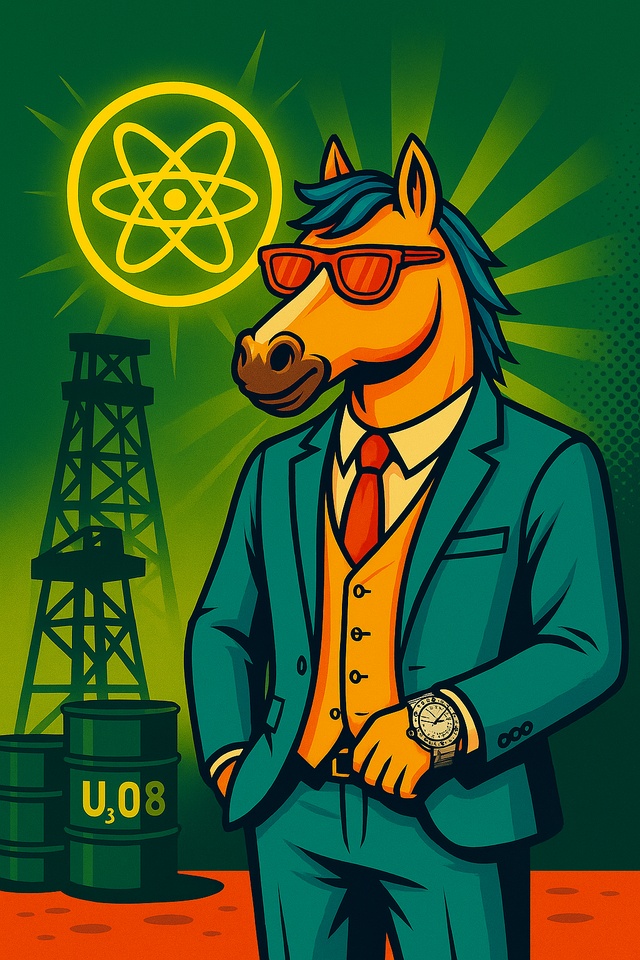Reading time: approx. 6-7 minutes

A few weeks ago, I described the structural appreciation of the uranium market as part of the supercycle approach: Supply deficits, geopolitical upheavals and the political turnaround in favor of nuclear energy mark the beginning of a multi-year uptrend. Today, reality provides the next piece of evidence - and $CCO (-5,06 %) (Cameco) is at the center of it.
Together with Westinghouse Electric and Brookfield Asset Management, the Canadian company is participating in a new $BAM (-2,45 %) Brookfield Asset Management in a new 80 billion US dollar energy offensive by the US government. The aim is to massively expand nuclear power capacities in the United States. The initiative is more than just a political signal: it is seen as a turning point in industrial policy and is intended to cover the entire cycle of civilian nuclear energy - from uranium mining to fuel processing and reactor technology. Supported by state guarantees and tax incentives, it marks an attempt to reduce dependence on Russia and China in the global uranium market.
For Cameco, this represents a decisive step: the Group, previously one of the largest uranium producers in the world, is increasingly becoming a political and economic partner of the Western energy transition. The combination of technological expertise, access to first-class deposits and now also political backing gives the company a strategic role that goes beyond simply extracting raw materials.
For me, today's news underlines why uranium is currently one of the most exciting sectors for long-term investors. My own supercycle portfolio reflects this logic: a tiered exposure along the entire value chain - from producers to physical storage companies. Cameco forms the core, the foundation of the positioning. In addition, I rely on $YCA (-1,11 %) (Yellow Cake) as a direct lever on the uranium price, as the company physically stores real stocks and thus offers pure price exposure. $NXE (-5,51 %) (NexGen Energy) stands for the exploration growth portion: a developer that controls one of the most promising uranium deposits in the world with the Arrow project in Canada. $DML (-5,93 %) (Denison Mines) contributes technological diversification - the focus is on the in-situ recovery method, which is intended to make uranium mining more efficient and environmentally friendly. Finally $PDN (+2,35 %) (Paladin Energy) complements the geographic diversification with a strong production focus in Namibia - a leverage to the supply shortage outside North America.
Together, these five stocks form a balanced cluster of substance and dynamism. Cameco and Yellow Cake stand for stability, NexGen, Denison and Paladin for speculative momentum in the early cycle. It is precisely this mix that is characteristic of phases in which structural scarcity coincides with political tailwinds.
Today's US initiative fits into a bigger picture. Nuclear energy is making a comeback worldwide: France is extending operating times and planning new EPR plants, Japan is reactivating reactors, China is continuously expanding its network, while countries such as Poland, the Czech Republic and Finland are initiating their own projects for the first time. After decades of underinvestment, there is a massive surge in demand - and supply is barely growing. Cameco controls some of the most productive mines in the world and is benefiting directly from the structural deficit.
The current cycle is following a familiar pattern: first prices stabilize after a long bear market, then political programs and investment waves meet tight capacity. We are right in the middle of this acceleration phase. The momentum is not the result of short-term speculation, but of real bottlenecks and industrial policy realignment.
Of course, the environment is not without risks. After the strong performance of recent quarters, temporary consolidations are possible, and uranium prices are also sensitive to geopolitical shifts. Regulatory uncertainties regarding new projects could also delay schedules. But the overarching story remains intact: Nuclear power is back - and with it those companies that supply the fuel.
Cameco is at the forefront of a growing ecosystem that stretches from Canada to Australia and Namibia. Participation in the US's 80 billion offensive shows that uranium is no longer a marginal issue, but is seen as a security policy factor. Investing in this super cycle at an early stage means investing not only in energy, but also in geopolitical stability.



